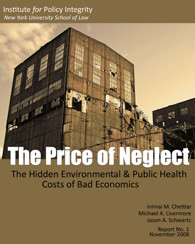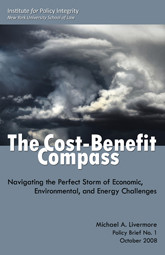-

The Price of Neglect
The Hidden Environmental and Public Health Costs of Bad Economics
This report examines the regulatory failures of the Bush years on issues as wide-ranging as climate change and workplace safety, and concludes that these failures did not arise because of an overuse of economics, but because economic and scientific evidence was ignored.
-
Letter to the EPA re: easing of restrictions on mountaintop coal mining
As part of a raft of midnight regulations, the U.S. Department of the Interior and the Environmental Protection Agency worked together to finalize regulations that ease restrictions on mountaintop coal mining—in particular how and when mining operations can deposit waste, rocks, and soil in or near streams.
-
Letter to the OMB re: refusal of health care services on moral grounds
In August 2008, the Department of Health and Human Services (HHS) proposed a regulation that would expand protections for medical professionals who refuse to provide health care services that they object to on moral grounds. Policy Integrity worked with a coalition of women’s health organizations to oppose the rule based on its finding that HHS ignored the negative consequences this policy could have on access to care, especially for women seeking reproductive health services.
-

The Cost-Benefit Compass
Navigating the Perfect Storm of Economic, Environmental, and Energy Challenges
The Cost-Benefit Compass: Navigating the Perfect Storm of Economic, Environmental, and Energy Challenges discusses how the next administration can use cost-benefit analysis to address the three great interrelated challenges facing the country.
-
Comments re: DOL regulations around toxic chemical risks
In August 2008, the Department of Labor (DOL) proposed a sweeping change to the way agencies treat toxic chemical risks in the workplace. The rule, which would change the assumptions about how long workers are exposed to hazardous chemicals, is extremely controversial and prompted an outcry from the public and Congress.
-
Comments in opposition to Physicians’ Conscience Regulation
In August 2008, the Department of Health and Human Services (HHS) proposed a regulation that would expand protections for medical professionals who refuse to provide health care services that they object to on moral grounds.
-
Statement of Principles for HEAP energy relief efforts
Economists know that when the cost of basic goods like energy increase, quality of life of decreases most for people with lower incomes. This is an important issue that government agencies should consider when estimating the effects of regulations.
-
Letter to David Paterson re: regulatory review
More than ever before, state governments now undertake an ambitious range of regulatory programs and often become leaders on environmental, health, and safety policies. As states expand their regulatory reach, it becomes increasingly important to ensure that statewide regulatory decisions are efficient, consistent, fair, and justified.
-

Cause or Cure?
Cost-Benefit Analysis and Regulatory Gridlock
In Cause or Cure?: Cost-Benefit Analysis and Regulatory Gridlock, Michael A. Livermore argues that cost-benefit analysis can be used to overcome regulatory paralysis. An earlier version of this working paper was presented at the Breaking the Logjam Conference at NYU Law in the spring of 2008.
-
Letter to the OMB re: midnight regulations
Agencies are infamous for pushing through regulations on the eve of an Administration’s exit. In May 2008, the Bush Administration issued a bulletin mandating that no regulations were to be proposed after June 1, 2008, except in extraordinary circumstances.
Viewing recent projects in Government Transparency
